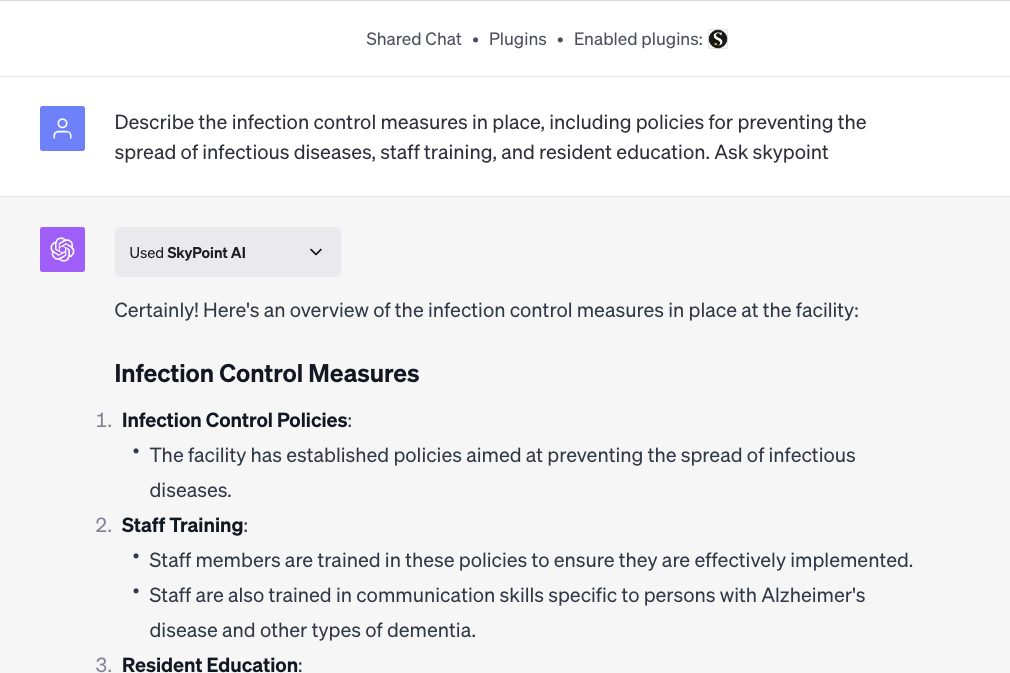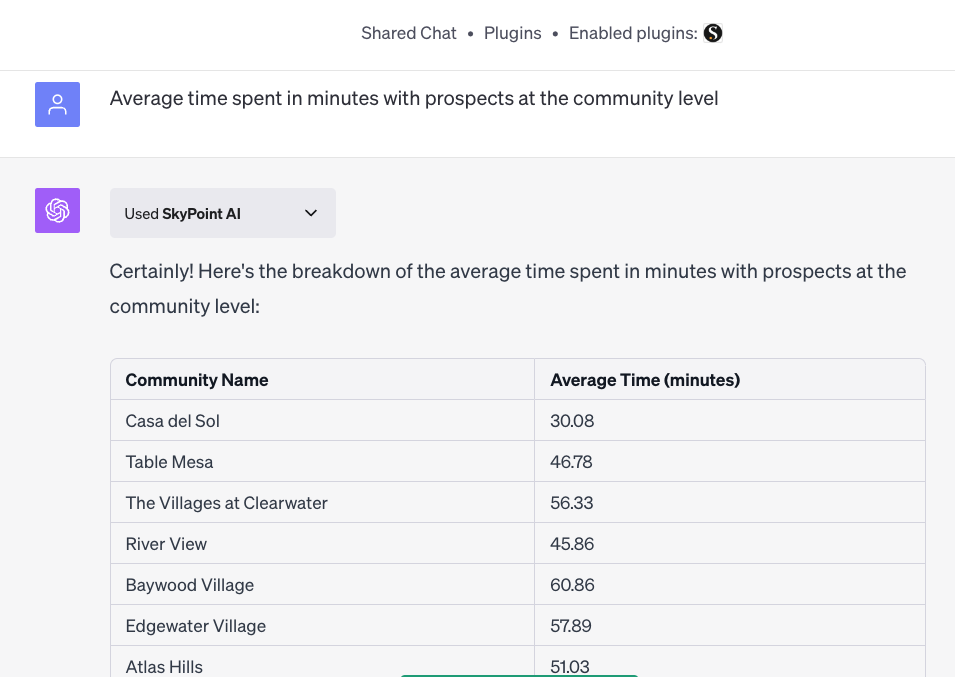We’ve all likely played around with ChatGPT or Bard at this point, which is based on publicly available information. Generative AI in this context refers to a similar conversational chat experience with private data.
To enable generative AI for enterprise use, you must first centralize and unify your data sources. Skypoint’s AI platform unifies your data estate to unlock the power of generative AI for immediate, accurate and industry specific answers across your organization. Skypoint lets you chat with your data in context.
Whether it’s data from your systems, or your policies and procedures, it’s important to understand the types of data that generative AI relies on to become an effective personal copilot.
Structured vs. Unstructured Data for AI
Structured Data
There are two main types of data that generative AI utilizes. Structured data is organized in a predefined format and is often found in your common systems and solutions from Electronic Health Records (EHR), ERP (Netsuite, SAP, Microsoft), CRM like Salesforce, or your HRIS system, your HR data.
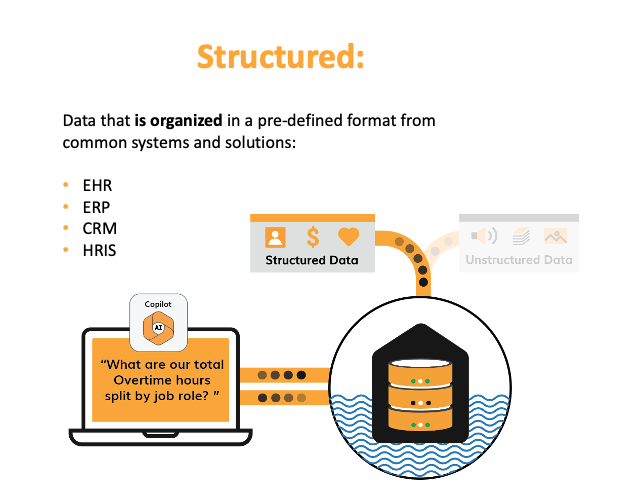
With this type of structured data, you can ask questions like “what are our total overtime hours split by job role?”. It’s well organized and follows a predefined structure. It’s great for traditional data analysis methods.
Unstructured Data
Unstructured data is the opposite. It’s data that’s not organized in a predefined way and doesn’t have a particular format. Text, emails, videos, audio, recordings, or anything that can’t be easily categorized into traditional databases, are all examples of unstructured data.
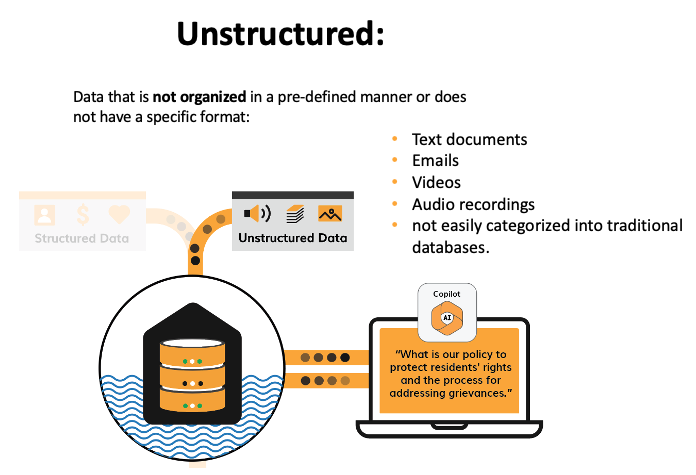
Unstructured data is where AI is pulling the best answers from your existing policies and procedures on what to do next for certain scenarios. Skypoint has its own private ChatGPT plugin through the OpenAI marketplace. Powered by the GPT-4 model, it provides users with instant insights about their own organization data through simple conversations. Whether you’re looking for last quarter’s sales numbers, internal policies, or even a personal care plan for a patient or resident — the Skypoint AI plugin provides instant answers without having to submit an internal ticket, email a department, or scouring internal systems.
Prior to AI, employees had to log into different systems, skim documents for policy info, scour spreadsheets, or simply wait on another human to find the data or answers to make a decision.
With Skypoint’s ChatGPT plugin, users can skip the mind-numbing search and make the best decisions to improve experiences across the continuum of care.
What’s Happening Behind the Scenes with Generative AI?
Every question you enter creates a unique line of code called a SQL query. You don’t have to know how to write code – the Copilots handle that for you automatically in the background. When you type a question, it’s simultaneously writing a SQL query, which gives specific instructions on what data to look for, where to look for it, and how to bring it back, much like instructing a librarian to find certain books based on specific criteria.
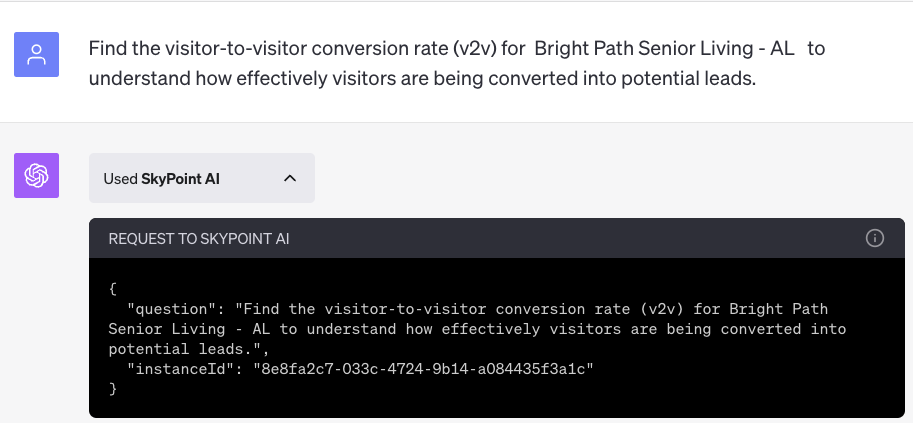
What Happens When Generative AI Doesn’t Have an Answer?
When generic AI tools don’t know the answer, don’t understand context, or can’t find what you are looking for, it will often make up a response, often with confidence. This is referred to as a “hallucination” and can be very dangerous, even deadly in certain settings like healthcare. We’ve taken stringent precautions to train our large language model (LLM) to prevent these hallucinations by either asking for clarity, or coming back with a canned error response, rather than making up answers that could be wrong.
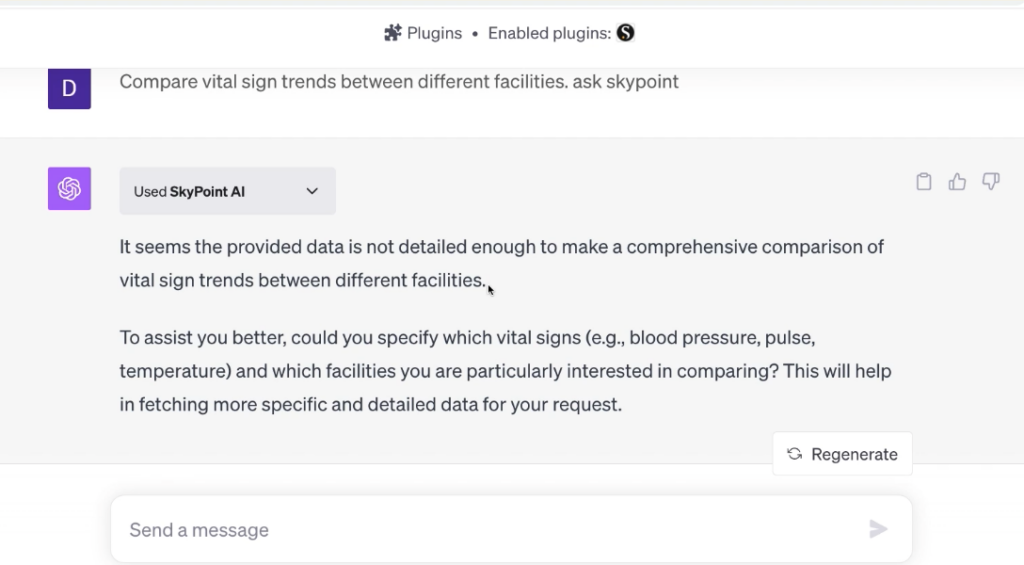
Here are some more industry-specific examples of using generative AI to chat with your data. These scenarios range from policies and procedures to clinical, operational, financial, sales and marketing, and even resident data.
1. Unstructured Data – Knowledge Management Prompts
“Describe the infection control measures in place, including policies for preventing the spread of infectious diseases, staff training, and resident education.”
When you enter a prompt like this, the AI copilot translates your plain language question into a SQL query and presents it to your secure database. This query searches for the relevant information, in this case it is your internal documentation that has been previously uploaded to your database (a more advanced database called a Lake House), so it’s grounded in context, and will return answers using industry-specific language the model has been trained on.
When you use a private AI Copilot, you won’t get the generic answers you’re used to. You’ll get information that is specific to your facility, organization, or portfolio, providing instant answers to about the policies and procedures.
Enabling Staff with Instant Answers, Grounded in Context
This is beneficial for staff and employees to be able to have instant access to these answers without having to go to HR or scour your internal systems to find this information. To make this happen, we take your internal documents and upload it to your private database so the AI Copilot can read it. This is referred to as knowledge management, and is the most applicable use case for organizations looking to leverage generative AI.
Here are some other example prompts related to internal policies & procedures:
- Resident Rights: what about our internal policies to protect resident rights and addressing grievances?
- Emergency Preparedness: What kind of plans do we have in place at our facility to be prepared in case of emergency,
- Email Correspondence: Can you write an email to a resident’s family member about our infection control measures
- State & Local Compliance: Explain how our facility ensures compliance with state regulations for skilled nursing or assisted living. Include details on licensing, inspections, and corrective actions.
- Infection Control Measures: Describe the infection control measures in place, including policies for preventing the spread of infectious diseases, staff training, and resident education.
- Employee Records Retention Policy: Discuss the importance of having a clear policy for accessing employee records. How does this policy align with federal and state law regarding record retention and privacy?
Let’s dive into some more industry-specific examples.
2. Unstructured Data Prompts – Clinical Knowledge Management
Like the knowledge management prompts, clinical knowledge management is another unstructured data type that refers to all the non-standardized information that is relevant to patient or resident care, but it’s not easily categorized into your traditional database. This can include:
- Doctor’s notes
- Audio or video recordings of patient or resident interactions
- Emails between healthcare providers
Instead of employees having to log in to a certain system or ask HR or email someone they can have this information right at their fingertips and it’s accurate grounded in context.
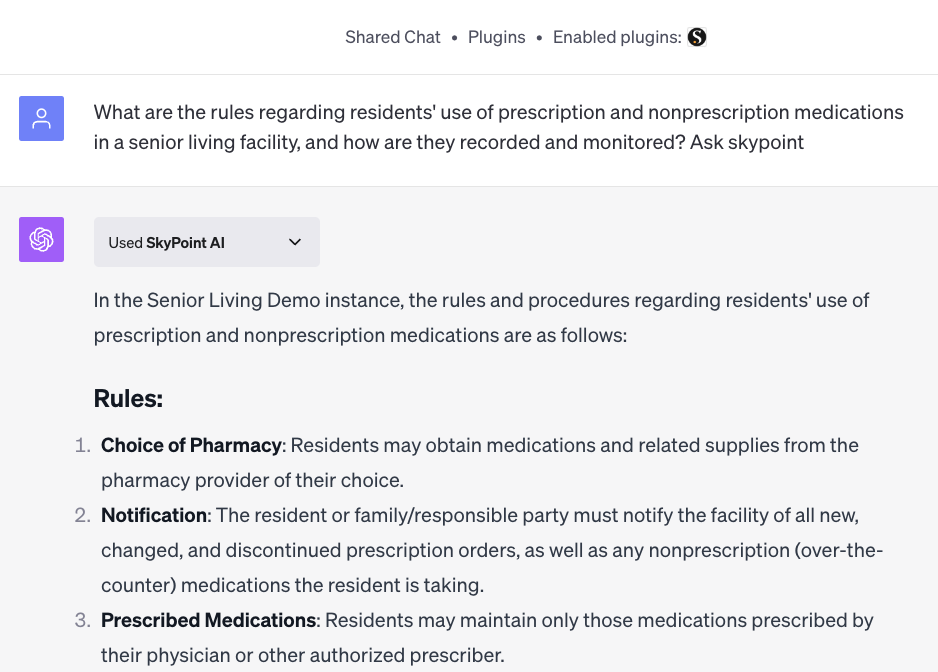
Here are some examples of using AI for knowledge management that correlate with policies & procedures for clinical scenarios:
- Discharge criteria for Alzheimer’s: What’s our discharge criteria for someone with Alzheimer’s or dementia?
- Medication Self-administration: What are the challenges that the elderly residents might face in managing and self-administering their own medication?
- Prescription Policy: What is our policy for prescription nonprescription medications in our facility?
- Resident discharge Policy: What’s the time frame for completing medical records following a resident discharge and what are the potential disciplinary actions for noncompliance?
- Food Allergy Policies: What are the key differences between managing food allergies and food intolerances? And how do you go about navigating this very important scenario?
3. Structured Data Prompts – Operational & Financial Data
Structured data are any of your common core systems, EHR, ERP, CRM or any industry specific solution. In your case it would source the information from whatever system it’s pulling from and list it specifically. PointClickCare, NetSuite, Salesforce, EPIC, are all examples of common industry solutions that utilize structured data. See our current integrations.
Example questions you could ask in this category include:
- Overtime hours split by job role
- Average time spent in minutes with the prospects at the community level across all of my community portfolios?
- Which community had the highest admission rate in 2022?
- What is my current resident count based on the type of living for all communities?
Your prompts don’t have to be written out perfectly. It can decipher missing words and based on the context of the conversation, can decipher what you are after from a data perspective.
4. Structured Data Prompts – Sales & Marketing Data
You can even extend generative AI prompts to your sales and marketing teams. Here are some top examples:
- Calculate the average percentage of closed sales for sunrise gardens retirement.
- Find the date with the highest number of initial home visits across all facilities
- Top 5 senior living facilities with the highest visitor-to-visitor conversion rate along with their conversion rates and facility names.
- Give me the breakdown of the average initial tour count per prospect for each facility
- Identify the 5 top-performing senior living facilities based on the number of finalized sales.
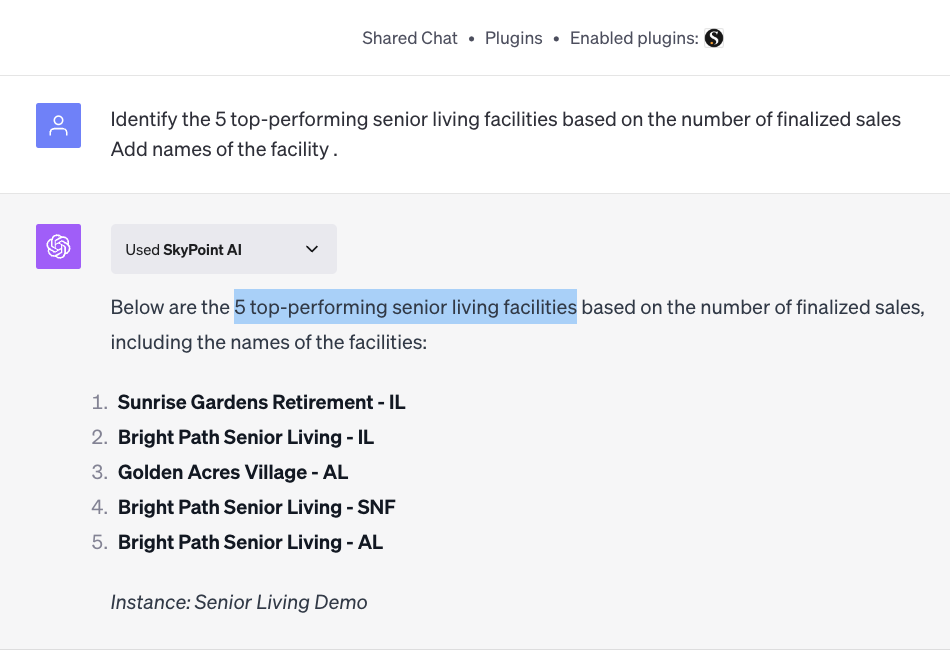
5. Structured Data Prompts – Clinical / Population Health / Patient / Resident
You can also ask questions about individuals in your records, like insurance information about a particular patient or resident. All the information in our demo instance is de-identified for demo purposes, but you can start to see the time savings accessing quick data this way rather than logging in to individual systems.

Example questions you could ask in this category include:
- Compare vital sign trends between different facilities.
- Calculate the correlation between blood pressure, pulse, and respiration.
- Compare BMI distributions between different facilities.
- Analyze vital signs during periods of elevated pain to understand physiological responses
- Analyze oxygen levels and respiration rates over time
- Could you provide me with the insurance details for the patient named Sheila Carter?
- Provide the most recent recording of vital signs for the resident with ID 65132
- Explore ‘Specialist Visit’ events for ‘Robert Baxter’ and their corresponding dates
- List all allergic reactions reported for the resident named Andrew, Salas
- Show the trend of weight changes for the resident named Loretta Mills over last 12 months
6. Combo Prompt Examples: Individual Records + Policies & Procedures
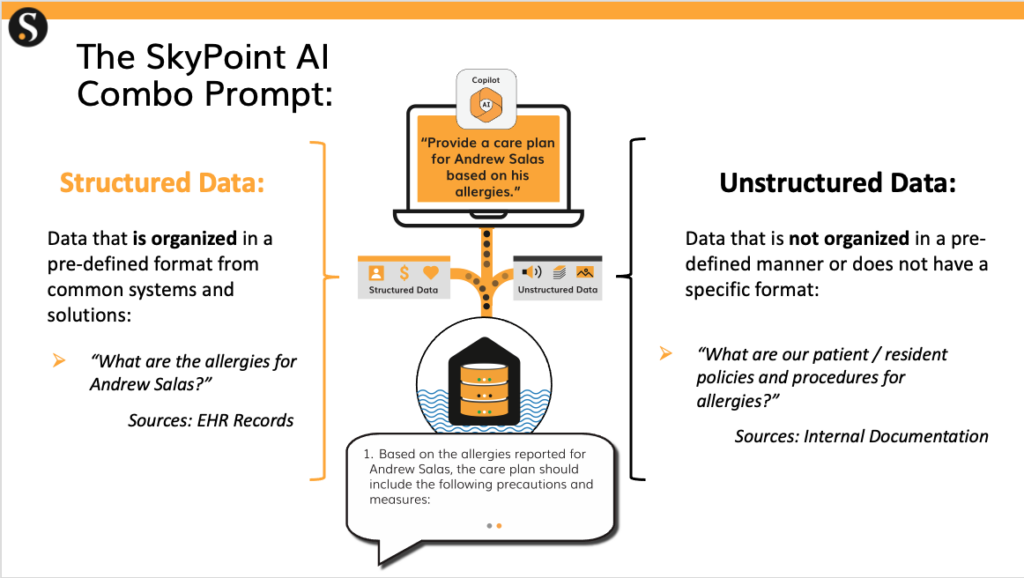
Combination prompts have quickly emerged as a crowd favorite. This type of question is a combo prompt that requires the LLM to assess two data sources to answer this question. The structured clinical data— in this case, allergy details sourced from EHR records. And two, unstructured knowledge management — your documented policies and procedures sourced from internal documents like your PDFs and Word documents.
There are also critical safety protocols built into the model to ensure privacy, safety, and accuracy.
So in this example, we received all the allergic reactions reported for the resident or patient Andrew Salas, and asked it to create a care plan for Andrew based on these allergies. This combination prompt connects the clinical structure data (Andrew’s allergies on file) with unstructured data which is knowledge management (the internal protocol for handling a patient / resident with allergies). These are our internal documents, processes, and procedures.
Based on these two factors, the AI Copilot can create a specific care plan for Andrew based on reported allergies. If any of those important factors is missing or broken, the model is trained to report back that context is missing. It will not make up an answer – which is often encountered with generic AI tools.
Generative AI is Your Copilot, not Your Replacement
It’s important to note to always work closely with medical professionals when administering these types of plans.
Generative AI is your copilot, but won’t fly the plane for you. These tools are your personal assistant to unlocking human potential and productivity to provide better care outcomes, or experiences.
These examples demonstrate how structured and unstructured data sources are used with generative AI in the Skypoint platform to chat with your data and enhance employee productivity across the organization.
Check out our 4-minute preview to see these prompts in action. Schedule a 30-min demo for a personalized walkthrough to see more examples.


